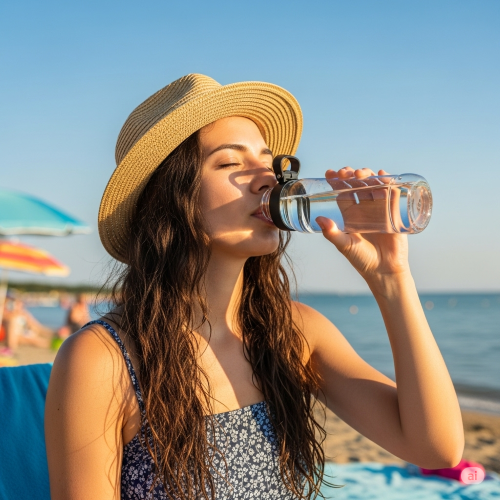When the summer heat hits, staying hydrated isn’t just refreshing—it’s essential for your health. While most of us know we need more water in hot weather, there’s a smart way to do it that supports your body and keeps you feeling great all season. Here’s a detailed guide—based on expert advice and medical research—to help you prevent dehydration and thrive through the heat.

Image:Generated by AI(Gemini)
1. Understand Why Dehydration Happens
Dehydration occurs when your body loses more fluids than it takes in. In summer, heat, humidity, sweat—and sometimes salt intake—combine and accelerate fluid loss. According to the Cleveland Clinic, if you’re already thirsty, you’re mildly dehydrated—so it’s crucial to drink before thirst sets in my.clevelandclinic.org.
Common signs include:
- Dry mouth or skin
- Dark yellow urine or reduced urination
- Headache, dizziness, fatigue
- Muscle cramps, rapid heartbeat
- Confusion or fainting in severe cases timesofindia.indiatimes.com+7food.unl.edu+7en.wikipedia.org+7uihc.org+4texashealth.org+4bluecrossvt.org+4
Unchecked, mild dehydration may escalate to heat exhaustion or even heat stroke—a serious medical emergency newsinhealth.nih.gov+15hopkinsmedicine.org+15texashealth.org+15.
2. Drink Smart: How Much & When
Don’t wait for thirst. The University of Iowa Hospitals recommends:
- Drink before heading outdoors—plan hydration
- Continue sipping every 15–20 minutes, 6 oz each time—approximately 24–32 oz/hour during heat exposure uabmedicine.org
General daily guidelines:
- Women: ~11.5 cups of fluids
- Men: ~15.5 cups uclahealth.org+15verywellhealth.com+15nutrition.gov+15
Adjust based on heat and activity, but remember: hydration begins before you feel thirsty texashealth.org+7uihc.org+7my.clevelandclinic.org+7.
3. Electrolytes: Why They Matter
When we sweat, we lose not only water but also electrolytes like sodium, potassium, and magnesium. Drinking plain water helps—but during heavy sweating, plain water can dilute electrolytes dangerously. Experts recommend pairing water with sodium-rich snacks or using balanced electrolyte drinks to maintain fluid and mineral levels verywellhealth.com+1thesun.co.uk+1.
Electrolyte beverages help prevent fatigue, muscle cramps, dizziness, and low mood during heatwaves thesun.co.uk. Still, for typical indoor days, water alone is often enough.
4. Hydrating Foods to the Rescue
About 20% of our daily fluids come from food, especially fruits and veggies with high water content marieclaire.co.uk+15nutrition.gov+15verywellhealth.com+15uclahealth.org+2directorsblog.health.azdhs.gov+2verywellhealth.com+2. Super refreshing options include:
- Watermelon (92%), cucumbers (96%), tomatoes (94%)
- Also peaches, strawberries, bell peppers, and celery verywellhealth.com+1dailytelegraph.com.au+1directorsblog.health.azdhs.gov+1uclahealth.org+1
Incorporating these into meals and snacks helps hydration naturally—even when you’re busy or outdoors.
5. Lifestyle Habits to Stay Hydrated
These easy habits support daily hydration:
- 🏃 Track water intake using mood bottles with time markers—motivational and proven effective
- 💧 Drink plain water consistently, not just after you sweat en.wikipedia.org+1verywellhealth.com+1
- 🚫 Avoid alcohol and excess caffeine, which act as mild diuretics and can worsen fluid loss en.wikipedia.org
- 🌿 Include light salt in daily diet or a little soup or electrolyte drink on hot days
6. Spotting Dehydration Early
Be alert to these warning signs:
- Thirst, dry mouth/lips
- Dark urine, infrequent urination
- Headaches, dizziness, fatigue
- Muscle cramps, rapid heartbeat texashealth.orgtimesofindia.indiatimes.com+2eatingwell.com+2uclahealth.org+2uihc.org+6food.unl.edu+6bluecrossvt.org+6
Severe dehydration may lead to fainting or confusion—seek medical help immediately if symptoms escalate .
7. Safety in the Sun
When outdoors in extreme heat:
- Avoid peak sun hours
- Dress in loose, light clothing and wear hats
- Stay in shade, use fans, and hydrate often hopkinsmedicine.org+15hopkinsmedicine.org+15food.unl.edu+15northside.com+4en.wikipedia.org+4verywellhealth.com+4
- Cool showers and humidifiers help regulate body temperature texashealth.org+10thetimes.co.uk+10timesofindia.indiatimes.com+10
These steps lower heat stress and reduce the risk of dehydration.
8. Special Considerations for Vulnerable Groups
Some people need extra care:
- Children often don’t know or tell you they’re thirsty
- Older adults may feel less thirsty but lose fluids more easily
- Athletes and laborers lose more fluids through sweat
- Pregnant women or those on medications—especially diuretics—require careful fluid and electrolyte balance
- Always hydrate proactively, not reactively, in these cases verywellhealth.com+8en.wikipedia.org+8time.com+8time.com+9thetimes.co.uk+9my.clevelandclinic.org+9en.wikipedia.orgnorthside.com+6time.com+6osha.gov+6
9. When Hydration Isn’t Enough—Seek Help
If you notice warning signs like fainting, confusion, rapid heartbeat, or inability to urinate, medical intervention may be needed. IV fluids or emergency care can save lives in cases of heat illness or severe dehydration .
🚰 Wrap-up: Hydration Strategy for Summer
- Before heat exposure: drink water
- Continuous sipping: every 15–20 minutes outdoors
- Balance electrolytes when sweating heavily
- Hydrating foods boost fluid intake
- Track intake and avoid diuretics
- Stay alert for symptoms and cool down
- Protect and hydrate vulnerable individuals
- Get help for heat emergencies
This holistic, expert-backed approach helps you stay cool, alert, and healthy all summer long.
답글 남기기